 Attention Rhizome.org members !
Attention Rhizome.org members !
ookoi this summer will work on a release of their forthcoming
"WINTERLAND" album in the form of a free interactive iPhone application
... We entered this year's commission competition at Rhizome's as a means to
ensure part of the funding needed for this project.
![]() Thank
you for viewing and voting for ookoi's
proposal !
Thank
you for viewing and voting for ookoi's
proposal !
[ Follow ookoi @ twitter.com ! ]
twitter.com/meesterwerk
may 03, 2009.
The recent surge of social network twitter.com has firmly established micro-blogging as one of today's most popular means of personal online expression. It is seen used by the young and the old, the timid and the bold, the ugly and the beautiful, by the more and by the less well-to-do, by the famous and by the obscure, by the over-exposed and by the neglected... Though - obviously - not all for the same reason, a great many specimens from these and other categories (or the 'ghost twitters' they employ, as will be the case for many of the famous and powerful that are 'on Twitter') may be found tweeting their way through their days.
Twitter's rise to ubiquity and mass medium status comes with quite a bit of debate, and an awful lot of ridiculing the found 'triviality' of a majority of the tweets that are being twittered across the web. Communication and inter-human relations based upon the sole exchange of ASCII messages containing at most 140 symbols of course makes an easy target for jester, irony and parody. Much of the thus phrased critique though is an awful lot like blaming a dog it is barking.
Except for its proper homologues, Twitter is surely not intended as a replacement or alternative for whatever other means of communication and on- or offline publication that we have at our disposal. Nor is it even approximately capable of eventually becoming such. And no one will oblige me to start sending out ≤ 140-character tweets instead of writing novels or posting lengthy soundblog entries; twittering about his of her life in a daily series of tweets will become mandatory for no one; and no one is - nor will be - obliged to pay attention to or even acknowledge the existence of whichever of the godknowshowmany daily tweets that are being posted all over the world.
On the other hand and also: no one will prohibit those that for some reason do choose to 'tweet' to be creative in the ways that 'they do it'.
And there are those that do.
If you are a Macintosh user and have seen a bit of Twitter, chances are that you'll be as enchanted as I was by Andrew Spitz's Tweet-A-Sound application. TAS is a simple (and free) sound synthesis tool that allows you to instantly post the ≤ 140-character code of the settings for a sound that you 'design' while playing with the application, as a tweet to a Twitter account.
Here's how such a 'sound tweet' will look like on Twitter:
#tas 0 0 199 82 333 82 521 69 585 29 666 0 0 0 147 45 533 69 666 0 0 0 0 0 0 0 0 0 493 2 2 50 4000 5 560 79 54 23 16 53 67 70 3
Conversely, you can import (in this first version of the application that means: copy/paste) a #tas-tweet, and play it in the TAS-application. The following two pictures show the application's two main screens: a screenshot of the 'make and post a sound' interface is shown to the left, and that of the 'play a sound tweet' interface to the right.
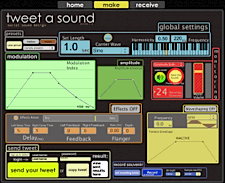 |
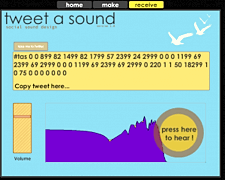 |
There are two interesting ideas here: the first is that the 140 characters of a tweet may be used to encode information other than 'messages in natural language' ( * ); the second is using the Twitter API to build stand-alone applications that enable one to publish such 'codes' to the Twitter network, and retrieve similar 'codes' from there for use and maybe further treatment in your application (that is: to communicate).
[  This SB-edition's podcast is a short montage
that I made with three or four more or less randomly picked sound-tweets,
as made in, and posted to Twitter via, TAS;
and also, of course, played back by me and recorded through the TAS
interface. ]
This SB-edition's podcast is a short montage
that I made with three or four more or less randomly picked sound-tweets,
as made in, and posted to Twitter via, TAS;
and also, of course, played back by me and recorded through the TAS
interface. ]
If developed somewhat further, TAS might become a fine tool to use in, for example, a 'sound injury'-type of net-music project, and I'm definitely curious to see whether and how Andrew Spitz, and maybe others, are going to take these ideas further.
There was another report of an interesting use of Twitter, in the Human Powered Chatbot workshop, which on march 24th took place as part of an exhibition at the Contemporary Museum in Baltimore. In this workshop participants were divided into two groups. Some were given a task as 'computational processors', others as subjective processors', by means of a set of simple rules that together turned them into sort of a writing machine, 'connected' to the internet. This 'human writing bot' was devised to create an 'endless chat loop', continuously de- and re-constructing Twitter status messages, Twitter replies, and the results of keyword searches on the NYT and Twitter websites.
Now be it a stack of paper and some pencils, a recording studio and a box full of instruments, a film camera and a bunch of actors, a Twitter account together with an internet connection and a computer ... there is nothing inherent in a tool or technology that will make the results of using it necessarily trivial and of little interest; just as of course - conversely - no tool or technology can guarantee the creation of your masterpiece.
With respect to Twitter, I think that the limit of 140 characters it imposes actually provides an interesting challenge. Like Dan Stowell, who observed in relation to his SCTwitts that it was "kind of like writing haiku for sc..." And as the above two examples demonstrate, smart and exciting things start being done using Twitter as a tool. I would not want to label them 'masterpieces', but there is absolutely nothing that excludes that one day soon someone will create a Twitter masterpiece, is there?
"everything is gonna be diff'rent
when I paint my masterpiece" ( ** )
Somebody will have to do it, so why not give it a go myself? In anticipation of its execution I thought I'd create an appropriate account for a such project. Both twitter.com/masterwork and twitter.com/masterpiece had been taken already, though. Also twitter.com/Meisterwerk and twitter.com/chefdoeuvre turned out to be no longer available ... Fortunately however, and much to my relief, the Dutch equivalents were free.
So now you know how and why I became both twitter.com/meesterwerk and twitter.com/meesterstuk. As a consequence, and taking things to their logical conclusion, my Twitter Masterwork will very likely be in Dutch ... Well, that's even better then, I'd say!
To bring this entry to its end, let me heartily invite all of you - friend or foe, whether you are native Dutch speakers or not - to follow me @meesterwerk, and to follow me @meesterstuk. I will, however, not even think about starting their creation before having gained some decent, critical mass of followers to witness. For if there is not, what would be the use? Could there be any, without a decent crowd to witness? Would there? With no-one there to see or hear, will not pretty much any-thing be a master-thing?
notes __ ::
(*) This was also observed and realized by others, for
example by Dan Stowell, who late march started tweeting SuperCollider
code chunks via his Twitter account.
This SCTwitting
was then picked up by others.) [
^ ]
(**) From the lyrics to 'When
I Paint My Masterpiece', by Bob Dylan [
^ ]
tags: twitter, micro-blogging
# .306.
smub.it | del.icio.us | Digg it! | reddit | StumbleUpon
comments for twitter.com/meesterwerk ::
|
Comments are disabled |
le petit paris : das kleine, ici
april 26, 2009.
Last month, on the occasion of Rinus van Alebeek´s most recent short séjour
in France, Ana-R joined forces with Radio
AligreFM's Songs Of Praise to provide the logistics necessary
to mount an edition of das kleine fieldrecordingsfestival in Paris.
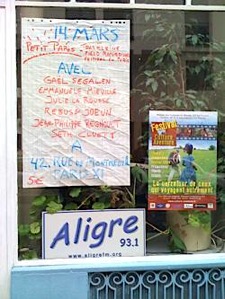 The space of Radio AligreFM,
in the rue de Montreuil, not far from Nation, was just the right spot for
this, and Cyril already for quite a while had been talking about wanting
to attempt to use it, for example for workshops or for this kind of presentations
(rather than concerts). Aligre principally uses it for occasional
staff- and other meetings; the studio is downstairs in the basement.
The space of Radio AligreFM,
in the rue de Montreuil, not far from Nation, was just the right spot for
this, and Cyril already for quite a while had been talking about wanting
to attempt to use it, for example for workshops or for this kind of presentations
(rather than concerts). Aligre principally uses it for occasional
staff- and other meetings; the studio is downstairs in the basement.
... And it thus came to pass that Rinus notified the fine fleur of fieldrecordists resident in Paris, who then pocketed recordings they had made all over the world and took them to the rue de Montreuil in the 11th arrondissement of the capital, where they gathered for the French premiere of das kleine, on saturday march 14th, 2009, a mere day after friday the 13th ...
Despite the pretty short notice Rinus managed to come up with a fine bill, and the first french edition of das kleine comprised six presentations. Alll of these consisted in the playback of soundfiles from a laptop, except for one, which was a direct playback of files from a Zoom digital recorder. In some cases the playback was nothing but that: playback; in other cases the artist did a 'live-mix' of files, with - sometimes more, sometimes less - instant interventions and decision making.
With the sole exception of a young man still planing on friday
the 13th's mesh of colors and sounds, who came flying up the rue de Montreuil
in search of something of an after-cirque, the audience had come to quietly
sit and listen.
So they did.
And sometimes closed their eyes ...
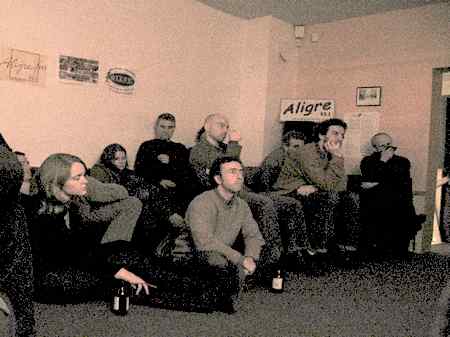
|
Two of the presenting artists at le petit paris had participated
- during 2008's summer - in the European
Sound Delta project, initiated and developed by the Paris based collectif
mu. A major part of that project was sort of a floating radio-art
laboratory consisting in two barges with varying radiophonic crews, navigating
upstream on the Rhine
and Danube
rivers from the North
Sea and the Black
Sea, that at the end of their respective cruises met in Strasbourg.
Both Gaël
Segalen and Jean-Philippe
Renoult (aka Jopo
Stereo) were European Sound Delta river residents, and at le petit
paris both presented work based on recordings they made during their
trans-European river trip.
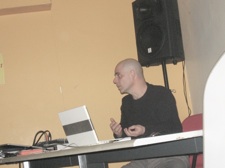 |
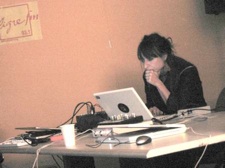 |
v - Jean-Philippe (in the left picture) brought us a sneak preview of 'Locked IN', a production for Kunstradio that was broadcast there the day after, on sunday march 15th. It is a radio adaptation of a number of lock concerts that Jean-Philippe did and recorded - together with Sarah Washington, Dinah Bird and Knut Aufermann - on the Danube. On its journey their barge trawled through some of the largest locks in Europe. The quartet used these narrow river-vaults, some of them up to some 25 meters high, for a series of in-situ improvisations using (mainly) battery powered electronic instruments. I do not know what these were exactly, but in the recording they sound a lot like crackle boxes. Sometimes vocals were projected through a megaphone, and they all the time played with the resonance of the locks and the sounds that were in and around them. The piece ends with Jean-Philippe playing his mouth organ, like a lonesome sailor far away from home, along to the rather bleak sound of running water, a squealing gull (or is it the lost crow?) and the desolate moaning and groaning of the lock gates. The sounds produced by the mechanics of the locks, even as mere recordings, are very impressive, and I can but try to imagine how it would feel to be myself on top of a ship at the bottom of a such tens of meters deep narrow rectangular cave, lined by moss-covered walls of concrete. During the projection of Jean-Philippe's piece at some point I closed my eyes, and I imagined myself there at night, sitting on deck and looking up at the framed sky and the stars above. The silence must have been deafening. And indeed, all things considered, I guess that in the end it was this silence of the locks that I longed to hear ...
ii - If I remember correctly, the radiophonic piece presented by Gaël (she's in the picture to the right above) was part of a series of documentary pieces based on her recordings and experiences during the trans-European Danube cruise. Gaël started off with an up-tempo beat made out of a recording of 'banging water' (or something like it). It was the overture to a dense mix, that alternated and overlapped travelsound-recordings with fragments from interviews (some in English, but many also in east-European languages that I do not understand; interviews probably - but I'm guessing here - with east-European artists that were resident on the boat for parts of the journey), on top of a sonic drive, that kept on pushing us forward and made (no joking!) Gaël's presentation this le petit paris's most danceable one. A bit too jittery and nervous at times, at least for my taste, it left me with the impression of listening to the soundtrack of a television documentary of which the images somewhere somehow had been lost...
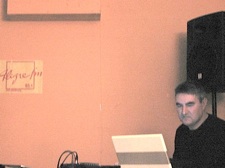 |
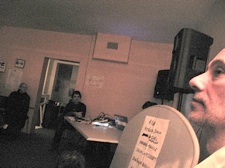 |
iii - Emmanuel Mieville (in the left picture) is a Paris born and based composer, who studied at the GRM and who quite literally was raised on musique concrète. Large parts of his presentation involved considerable - and in general not uninteresting - (electronic) treatment of field recordings, that he made on his travels to non-european countries; but where precisely, I forgot. Emmanuel started his set with some of the mean- and dirty-est sounding creaks and cracks yet heard that afternoon. He then led us on through noisy city streets ... There he had us waiting for several minutes at a pedestrians' crossing, next to one of those rhythmic audio signaling devices for the visually handicapped (beeper), before letting the city for a while give way to a more rural scene with bird song ... But hold on! We were not supposed to start to take things too easy too quickly, for soon after the bird sing we are warped back again into the midst of the roar of polluting cars that seemed to be circling the voice of some sort of a public speaker, backed by the bumping beat of pop sounding from a car-stereo; or maybe it comes from a boom box? Before I can make up my mind we are slid forth again, via electronically 'long-smeared' percussion sounds, once more off into a much quieter region. With poultry now; including a rooster that manifests considerable difficulty in properly finishing his cock-a-doodle-dos. And - again - there is the song of sing birds, which then finally, in the last part of the piece, are being joined by adhan, the chanted islamic call to prayer, before fading all out into a jubilatory restfulness ...
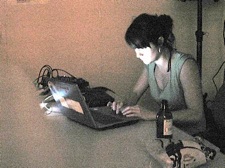 |
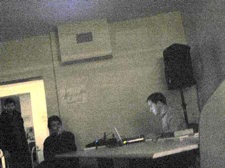 |
iv - Julie La Rousse (in the left-hand picture) had just returned from a trip to Chile. She served us an audiomulch-ed cocktail from recordings made during that journey, in what seemed the most spontaneous of the six petit paris presentations. While she shook her mix, layering and overlapping field recordings on top of a rumbling drone that I imagined being - or signifying - the drone of the airplane's engines, flying her from Paris to Santiago or the other way round, I actually caught Julie smiling broadly at some of the sounds & signs parading across the screen of her lap-top, as if in recalling just how things were (« was der Fall war ») at the time of their recording. Also Gaël smiled vaguely once or twice, a little bit. But surely none of the others did, at least not during their presentation. No way, Charlay ...! So Julie's smiles were kind of a relief. They were a happy view, and it was as if I could see her remember. I liked that, and a fortiori I enjoyed her mix, which was sort of rough and edgy, including the sound of street works and (mulch-)tuned church bells. There was, as a matter fact, also an awful lot of barking involved... Whose dog was that?
vi -Seth Cluett (in picture to the right) is an american artist and composer currently doing his doctoral research (on the loud-speaker as art object and musical space) at the Parisian Observatoire Musical Français - Musique, Informatique et Nouvelles Technologies. Seth presented a mix of a selection from the field recordings that he has been making ("as a tourist," he said, "for that is how one always will consider me here") during his stay in Paris, many of which had a rather unusual 'point d'écoute': they were made with geophones, that he 'buried' at different spots in the city. At the Place de la Concorde, for instance, or in the wall of the tunnel of the Canal Saint-Martin.
i - Heard thus from below,
we find a Paris that seems other than the one that was registered by Emmanuel
Rébus and Kim Joeun, who signed for the sixth in this series
of six petit paris presentations; mentioned here last, but it was
their selection of short direct-to-Zoom recordings that in fact
opened the first Parisian edition of das kleine. Emmanuel and Kim's
recordings are dedicated to the korean 'dada-surrealist' poet Yi
Sang, who died in Tokyo in 1937, at the age of 27.
It had been Yi Sang's dream, Rébus told us, to one day visit Paris. But
he never could; he never did. Rébus and Kim Joeun therefore decided to 'virtually'
make the poet's dream come true, more than seventy years after his demise.
They selected a number of spots in Paris (in Montmartre mostly), each with
its own peculiar 'soundscape': metro, street, a terrace, a public
garden ... Each selected city soundscape acted as a sonic canvas
on which Kim Joeun then drew Yi Sang's
poems, as she recited them in korean in these public places in Paris.
By this - ritualistic - geste,
the poet, seventy years after his unduly dead, undoubtedly indeed did
visit Paris ... The resulting, un-edited, 'field recordings' are little
gems. I found them truly touching, as much because of
the utter simplicity of their means, as through the
efficaciousness and the thoughtfulness with which they reach their set goal.
Only so little does it take ...
tags: das kleine, fieldrecording, Paris, phonography
# .305.
smub.it |del.icio.us | Digg it! | reddit | StumbleUpon
comments for le petit paris : das kleine, ici ::
|
Comments are disabled |